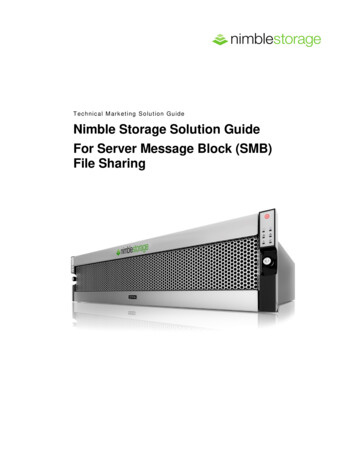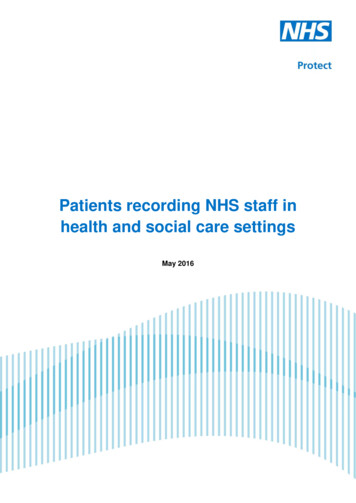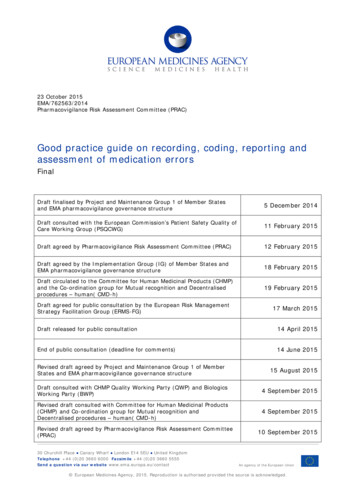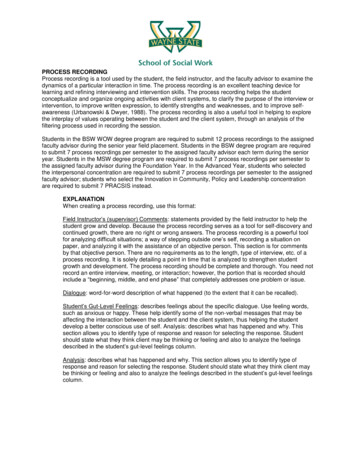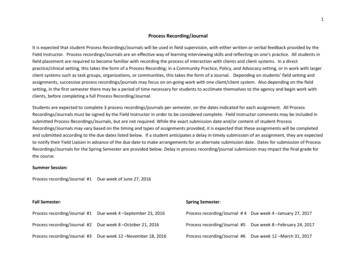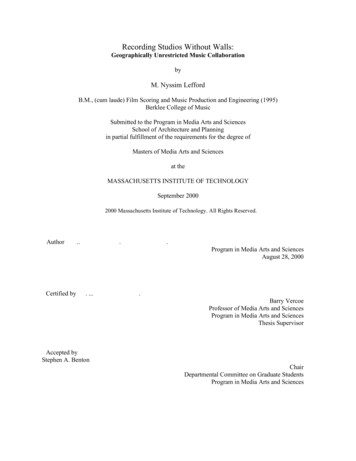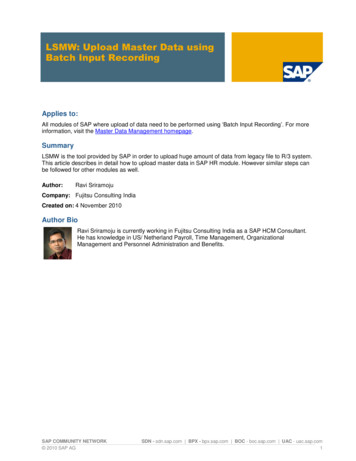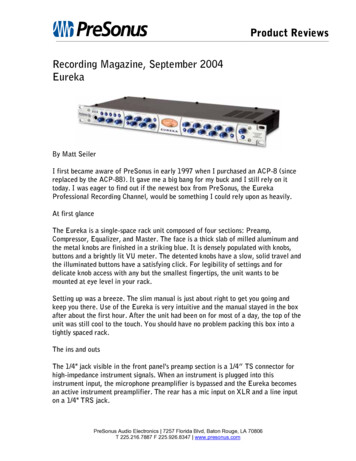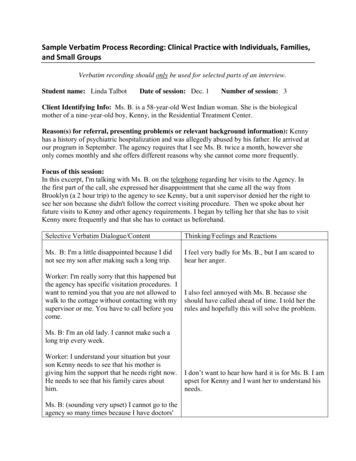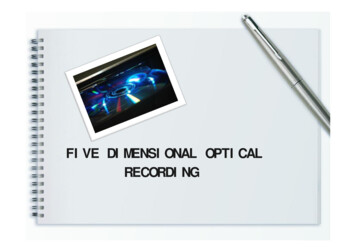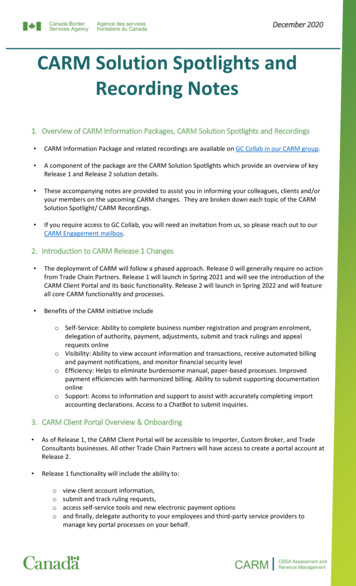
Transcription
December 2020CARM Solution Spotlights andRecording Notes1. Overview of CARM Information Packages, CARM Solution Spotlights and Recordings CARM Information Package and related recordings are available on GC Collab in our CARM group. A component of the package are the CARM Solution Spotlights which provide an overview of keyRelease 1 and Release 2 solution details. These accompanying notes are provided to assist you in informing your colleagues, clients and/oryour members on the upcoming CARM changes. They are broken down each topic of the CARMSolution Spotlight/ CARM Recordings. If you require access to GC Collab, you will need an invitation from us, so please reach out to ourCARM Engagement mailbox.2. Introduction to CARM Release 1 Changes The deployment of CARM will follow a phased approach. Release 0 will generally require no actionfrom Trade Chain Partners. Release 1 will launch in Spring 2021 and will see the introduction of theCARM Client Portal and its basic functionality. Release 2 will launch in Spring 2022 and will featureall core CARM functionality and processes. Benefits of the CARM initiative includeo Self-Service: Ability to complete business number registration and program enrolment,delegation of authority, payment, adjustments, submit and track rulings and appealrequests onlineo Visibility: Ability to view account information and transactions, receive automated billingand payment notifications, and monitor financial security levelo Efficiency: Helps to eliminate burdensome manual, paper-based processes. Improvedpayment efficiencies with harmonized billing. Ability to submit supporting documentationonlineo Support: Access to information and support to assist with accurately completing importaccounting declarations. Access to a ChatBot to submit inquiries.3. CARM Client Portal Overview & Onboarding As of Release 1, the CARM Client Portal will be accessible to Importer, Custom Broker, and TradeConsultants businesses. All other Trade Chain Partners will have access to create a portal account atRelease 2. Release 1 functionality will include the ability to:ooooview client account information,submit and track ruling requests,access self-service tools and new electronic payment optionsand finally, delegate authority to your employees and third-party service providers tomanage key portal processes on your behalf.CARMCBSA Assessment andRevenue Management
CARM CBSA Assessment andRevenue ManagementCARM Release 2 will feature additional capabilities such as: registering your business to obtain a business number (BN9) and enrolling in programs andacquiring a RM account or Program ID (RM15); submitting the new Commercial Accounting Declaration (CAD), with the ability to submitadjustments electronically with increased visibility into the status of the adjustment; new reporting capabilities, including the ability to extract your account data; and, and finally, submitting and tracking appeals through the portal. The CARM Client Portal will increase visibility and control over accounting and revenuemanagement processes for Trade Chain Partners, with new online self-service tools available, allaccessible by following a simple online onboarding process. Creating an account and onboarding onto the CARM Client Portal is a very simple process.o If you have not previously transacted business with the CBSA, follow this step otherwise skip tostep #2. Obtain a Business Number and RM by following the current process to obtain aBusiness Number (BN) and RM account through the Canada Revenue Agency. This process willstill be manual and paper-based until Release 2 of CARM.o Step #2 – Create an Individual User Portal Account by going to the CARM Client Portal page, andlogging into the portal using one of the following login credentials: GC Keyor a Sign-In Partnero Step #3 – Once you’ve created your individual account, you will need to link your user accountwith your Business Account. If you have been designated as the Business Account Manager(BAM) for your company, you must complete this step. You will need to provide your RMaccount credential and answer the following questions: Legal entity name of the business and full address informationTwo of the following three transactional questions: transaction number and associatedduties & taxes, last transaction payment amount, or last Statement of Account balanceo Step #4 – With access to your company’s business account, there is still one crucial step that youwill want to do before you begin using the portal to transact business with the CBSA. If you usea customs broker, or have other employees in your company that deal with your importations,you must Delegate Access to Employees or Representatives. This is a key step of the onboarding process, and is further detailed in the Delegation ofAuthority Solution Spotlight and the corresponding Delegation of Authority recording.o Step #5 – Once the above steps are complete, you are now ready to Conduct Business with theCBSA. For Release 1, you can request a ruling, view your transaction history, view yourStatement of Account, make payments, and use self-service tools. See CARM Solution Spotlights for Account Overview and Payment Processing, and Rulingsfor more information.Key Takeaways for CARM Client Portal Overview and Onboardingo The CARM Client Portal will provide self-service tools and increased visibility and controlover accounting and revenue management process.o Basic portal functionality will be introduced to the trade chain community with Release 1.Whereas, full CARM functionality will be made available in Release 2.2
CARMCBSA Assessment andRevenue Managemento Importers, Custom Brokers, and Trade Consultants businesses will have access to the CARMClient Portal in Release 1.4. Delegation of Authority Through the CARM Client Portal, Trade Chain Partners will be able to delegate access to theirportal account to their employees and to their third-party service providers to manage commercialimportation activities on their behalf. This process differs from the business registration process, in that the act of delegating access toboth your own employees and third-party service providers serves to reproduce your internalorganizational structure and business-to-business relationship. If importers would like their customs broker to manage their account and perform transactions ontheir behalf (e.g., submit rulings, set up their delegated access) they will need to delegate theircustoms broker access to their portal account. After CARM Release 2, conducting certainimporting activities on behalf of a client, such as the accounting declaration submission, may notbe possible without proper delegation of authority within the portal. When Release 1 goes live, importers, customs brokers, trade consultants will have access to theportal, and consequently the ability to delegate access to their business account. The delegatormust have a user portal account that is linked to their business, and the delegatee must also havea user portal account. A key benefit that will come from this change is that it will provide Trade Chain Partners withsignificantly greater control and visibility over who has access to their business account. Another key feature that will benefit the trade chain community is that Trade Chain Partners willhave the ability to manage user access based on specific roles and visibility rules, with the ability topreview the specific functions a user will be able to access in their delegated role.Delegation of Authority – Overview of access roles in the CARM Client Portal In the portal, there are many different ways to segment access to a business account. Thefollowing details how access can be managed within the portal. Starting with the important Business Account Manager role, this role possesses the highest level ofmanagement access over a business account, with complete read, write, and edit privileges.Therefore, the Business Account Manager should be an active operational user and not necessarilythe owner/CEO of the company. We understand that only certain key leaders will have therequired legal information to link their business account in the CCP, so it is up to the business ifthey’d like to equip an active operational user with the necessary legal information to link theirbusiness account, or have an executive from the business complete the initial setup of theirbusiness account. Either way, since this role is of the utmost importance with unique privileges, itis highly recommended that businesses assign at least two Business Account Managers. The portalwill periodically remind the single Business Account Manager if he or she has not delegated asecond Business Account Manager. The next role one can have in the CARM Client Portal is of a Program Account Manager.o An example of this role is Luc, who is a Program Account Manager at ABC Inc. He has theability to modify program registration information, grant access to employees of hisProgram and create, edit and view all Program transaction information. He assumes therole of Program Account Manager (PAM). Following this we have Editor. In our example, Edward is an Editor which means he can create, edit,and view all transaction information for a Program.3
CARMCBSA Assessment andRevenue Management Next we have the role of Reader, who is able to see all transaction information for a Program but isunable to create or edit information. There are two types of roles a third-party service provider can assume when accessing a client’saccount in the CARM Client Portal. The first role with the most access is a Third Party BusinessAccount Manager. In our example, Lucie assumes this role, and therefore, although she cannotmodify them, Lucie has the ability to accept new employees to the business, and request 3rd partybusiness relationships with clients. Next, we have the Third Party Program Account Manager. In our example, Ron assumes this roleand has the ability to grant access to his employees to a client Program and is able to create, edit,and view all transaction information from a client Program. Finally, the last role highlighted here is an Orphan user, who has either not linked her business inthe CARM Client Portal, or has not been accepted as an employee of her company. To further make it simple for businesses to understand their access structure, Business AccountManagers will be able to preview the access users have to their business account, based on thespecific functionality that they will be able to use in the portal. Overall, the CARM Client Portal givesTrade Chain Partners flexibility to ensure that their employees and third-party service providershave access to what they need, and only what they need. Since the goal of the Delegation of Authority process is to represent true organizational structuresand business-to-business relationship environments, it was important that CARM allowedbusinesses to be able to manage the visibility of their transactions amongst their third-party serviceproviders. The Business Account Manager can choose the visibility of what their third party serviceprovider can see, with options to allow this service provider to access transactions self-submitted bythe importer or other third-party service providers. Note that a third-party service provider canalways access what they submitted themselves, by default. Our example of this in action is of Sandra from DEF Brokerage who needs to make a changeto another customs broker’s transaction. Therefore, she works with her importer client’sBusiness Account Manager so that they grant her the additional visibility required toperform this action.Delegation of Authority - Key steps to delegate access to a business account The delegation of authority process is simple, with key steps to follow to ensure your accessstructure is accurately representative of your organizational structure and third-party relationships. The precursor to delegating access to your business account is to first create your individual userportal account, and then register your business with the portal, if you are the Business AccountManager. This applies for all businesses who wish to have access to the portal. See the CARM ClientPortal Overview and Onboarding solution spotlight and recording for more details on theprerequisite steps. The steps to follow is where the delegation of authority process begins. We can separate theprocess into importer activity and third party service provider activity. Starting with the importer stream first:1. Upon creating their individual user account, employees of the Importer business will need torequest access to their company’s account.2. Next, the Business Account Manager and/or Program Account Manager of the Importer willneed to accept, or reject, the access requests that they receive from third party service providerbusinesses and/or employees from their own company and assign the specific kinds of accessand visibility to these individuals for them to access their business account.4
CARM CBSA Assessment andRevenue ManagementFor the third party service provider stream, the steps are very similar but with a few keydifferences:1. Upon creating their individual user account, employees of the third party service providerbusiness will need to request access to their company’s account2. Next, the Business Account Manager and/or Program Account Manager of the third-partyservice provider business will need to accept, or reject, the access requests that theyreceived from the employees from their own company and assign the specific kinds ofaccess and visibility to these individuals for them to access their business account.3. Then, the Business Account Manager of the third-party service provider business will needto request access to their client’s CCP account. Only the Business Account Manager of the third party service provider will be able torequest access to a client’s business account in the CCP. Note: Only customs brokers, and Trade Chain Partners who are registered as thirdparty providers (in R2) will be able request access to another business.4. Once the client grants access to their account, the Business Account Manager and/orProgram Account Manager of the third-party service provider business will need to delegateaccess to the client’s account to the appropriate employees in their third-party serviceprovider organization. From there, they assign the specific kinds of access and visibility theseindividuals require to work on this client’s account.Delegation of Authority - Key Takeaways As one of the key pieces of the CARM solution, ensuring your business understands how thisdelegation of authority process will work, along with ensuring you prepare appropriately will becritical to the success of the CARM initiative. Trade Chain Partners will have flexibility to manage access to specific employees, based on specificroles and visibility rules. Therefore, you have significant amount of control related to who hasaccess to your account. Customs Brokers and Trade Consultants will need to work with their importer clients to create adelegation of authority relationship within the CARM Client Portal, in advance of Release 2.o Due to the importance of delegation in the portal, and the dependency this process willhave on future Commercial Accounting Declaration (CAD) submissions, it is very importantthat Trade Chain Partners begin to discuss how to adjust their working relationships withthird-party providers, as well as determine how to change internal processes to account forthis new functionality. In addition to preparing for new processes related to delegating access, client should immediatelystart considering who from your organization will be the Business Account Manager, along withhow you will structure your access privileges amongst your employees and customs broker(s).5. Accounting Overview & Payment Processing As of Release 1, Importers, Customs Brokers, and Trade Consultants will have access to an onlineview of transactions posted to their accounts. Other client types will continue to access thisinformation through existing methods, until Release 2. Statement of Accounts (SOAs) will be available for viewing on the CARM Client Portal, and/or willbe distributed via the Electronic Data Interchange (EDI). This will make it significantly easier for5
CARMCBSA Assessment andRevenue Managementtrade chain partners to access their SOA or transaction history, since they will no longer have torely on a service provider or a trip to their local CBSA office. It is important to note that only financial transaction information will be available in the CARMClient Portal at Release 1. Other transactions such as declaration information will only becomeavailable at Release 2. In addition to easier access to transaction information, Release 1 will provide greater flexibilitythrough new electronic payment options. These new options include : Pre-Authorized Debit (PAD),credit card, and debit. Credit card payments will be permitted for up to 5000 in amount owing. While new payment methods are being introduced, some current payment options are set to bephased out by Release 2.Account Overview & Payment Processing – Transaction History Clients will be able to view their transaction history on the CARM Client Portal. Users will be able to filter their transaction data in a number of ways, such as filtering by billingcycle so that you only see transactions for a given billing period. Users will also have the ability todownload the data in traditional spreadsheet-friendly formats, such as CSV and XML. It is important to note however that only transactional data generated after the implementation ofRelease 1 go-live will be accessible through the CARM Client Portal. Transactional data generatedprior to Release 1 will not be available in the portal.Account Overview & Payment Processing – Key Takeaways To summarize, the first release of CARM will modernize how importing accounting information iscaptured, bringing clients closer to their data, while also providing additional options whentransacting with the CBSA. CBSA clients will be able to access their transaction history through the CARM Client Portal. Thiswill provide increased visibility, and easier access their own data, on their own time. At Release 1, Pre-Authorized Debit (PAD) and credit card will be introduced as new paymentoptions via the CCP Cash, bank cheque and remittance payment methods will no longer be accepted by the CBSA afterRelease 2 for commercial importations. These payment methods may however be accepted inother streams of CBSA business, such as for travellers.6. Rulings At CARM Release 1, rulings will be able to be processed electronically through the CARM ClientPortal (CCP). This applies to Advance Rulings (AR) and National Customs Rulings (NCR), as well asSame Condition Rulings (SCRs). Under CARM, the rulings process is very simple and straightforward. As it is done today, rulings willbe initiated by either the Trade Chain Partner or the CBSA, except now under CARM, the TradeChain Partner will be able to initiate a ruling through the CARM Client Portal. A key change under CARM is that Trade Chain Partners will be able to view the status of each rulingrequest and track it’s progress, during the lifecycle of the ruling. Furthermore, the CBSA may ask, asthey do today, for additional information or documentation, which Trade Chain Partners can easilyprovide via the portal (e.g., attaching documents).6
CARMCBSA Assessment andRevenue Management Once the ruling is processed, Trade Chain Partners will receive the ruling decision via the CARMClient Portal, including a notification and formal letter. From here, two possibilities follow this step: Trade Chain Partners will be able to appeal the rulingdecision. However, only at R2 will rulings will be able to appealed through the portal. Until then,Trade Chain Partners will need to use the current-stat
a customs broker, or have other employees in your company that deal with your importations, you must Delegate Access to Employees or Representatives. This is a key step of the onboarding process, and is further detailed in the Delegation of Authority Solution Spotlight
